|
“I feel proud of myself because I got to make all of the
things I wanted to tell everyone. Because people wants to know how I
lived in Burundi.”
–Aaliyah, arrived from Burundi in 2010
“I do it for the people. They need to see how I am in my country. You know, it’s not good in my country.”
–Ameer, arrived from Iraq in 2010
“I learned that the United States is made out of immigrants…I
never knew that, and it was just really interesting to me because it
just made me think about everybody.”
–Keegan, whose ancestor arrived from Poland in 1912
These are just a few of the heartfelt reflections from students
Grades 3–5 following the completion of their own family immigration
stories, which they carefully crafted in pictures and in words
(Olshansky, 2015). Newcomers reconstructed their family’s recent journey
from their native country to the United States; students whose families
immigrated long ago reconstructed the imagined journey of their first
ancestor to travel to America. Though students’ pride in their published
books was palpable, what also became apparent was the way this
bookmaking project transformed not only the culture of the classroom and
the school community, but also that of the greater community beyond the
school walls.
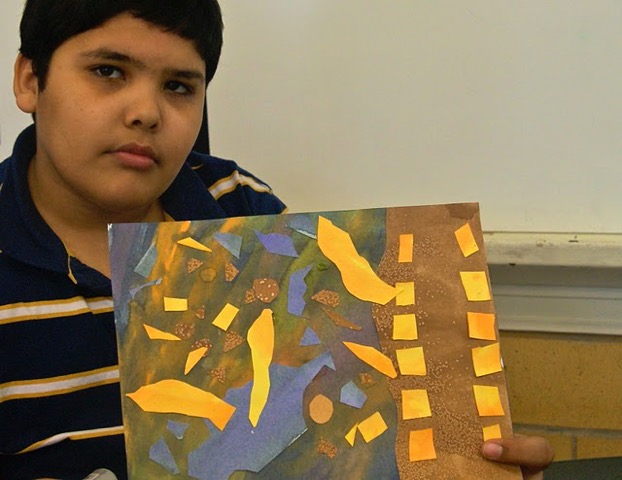
Abdullah displaying his work.
A Universal Language
The process used to create family immigration stories is known
as “image-making within the writing process.” This collage-based
approach to teaching writing and strengthening reading was originally
validated by the U.S. Department of Education as an innovative and
effective literacy program in 1993 (Olshansky, 2008). Because pictures
serve as a universal language, the image-making process has found a
natural home among English learners and their teachers. It has also been
used by classroom teachers who recognize the diversity of learners
within their own classroom community. Proven effective for a wide range
of learners (Frankel, 2011) and easily integrated into the social
studies and science curriculum, this enticing pictures-first approach to
writing has reached new heights of personal engagement when applied to
crafting family immigration stories.
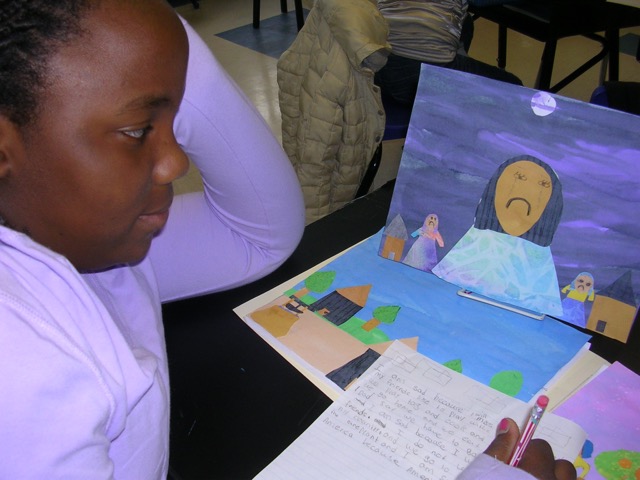
Kara looking over her work.
A Unique Visual Approach to Literacy Learning
Unlike most approaches to teaching writing which focus on the
written word, image-making within the writing process is designed to
support students who, for one reason or another, have difficulty with
written or spoken language. Visual tools for thinking, developing, and
recording ideas are woven throughout the process.
Students began this immigration unit by watching a short video
entitled Our Stories in Pictures and Words as Told by Immigrant
and Refugee Children (Olshansky, 2010).
During this 13-minute film, students are invited into the classroom of
English learners in the process of creating their own family immigration
stories using collage from hand-painted papers. While viewers were
introduced to the process and the stunning books the English learners
created, they also learned about the circumstances that resulted in
families recently fleeing their country. This awareness helped set the
stage for students to create their own image-making immigration stories.
English learners saw that it was alright to share their stories and, in
fact, witnessed the pride fellow newcomers experienced after creating
their own books. As recent arrivals, they understood that it was an
important, and particularly meaningful, personal accomplishment. In the
video, Priyanka reflected, “In Nepal we didn’t do like that. We don’t
have color to do like that. And we didn’t have paper, and we didn’t glue
like that. I didn’t think in America I do like that, to make that book”
(Olshansky, 2010).
For students whose ancestors arrived long ago, watching the
film of children their own age sharing their stories was particularly
moving. Attending school in a rural New Hampshire community that lacks
diversity, students found the immigration stories of their peers
poignant and eye opening. Third grader Lizzy confessed, “I actually
didn’t know that there are people still immigrating and coming today.”
Leah acknowledged, “I learned that the Webster kids went through things
that I could never imagine.” Liam added, “If I were an immigrant and
immigrating to a different country it would be really tough” (Olshansky,
2015). This was the first of many discussions in which students with
well-established roots in this country displayed empathy and compassion
for those students who had recently immigrated.
During this partnership between students from two very
disparate communities, English learners discovered that almost everyone
in the United States originally came from somewhere else. This helped to
establish some common ground with others in their community. As for
those students whose ancestors arrived long ago, most had never before
considered where their families originated. This triggered a natural
curiosity about their family stories. Alec explained, “Well I knew that
the Pilgrims came for religious reasons, so I was wondering about my
family, where did they come from and why” (Olshansky, 2015).
Quality Picture Books as Mentor Texts
Because the image-making process is designed to meet the needs
of a wide range of learners, it relies heavily on use of the visual and
tactile modalities. Teachers use quality picture books as mentor texts.
These books, often historical fiction, depict their content in both
pictures and words. This is particularly helpful for English learners,
though the illustrations in these books are used as visual resources by
all students when it comes time to depict various aspects of their own
or their ancestors’ journey.
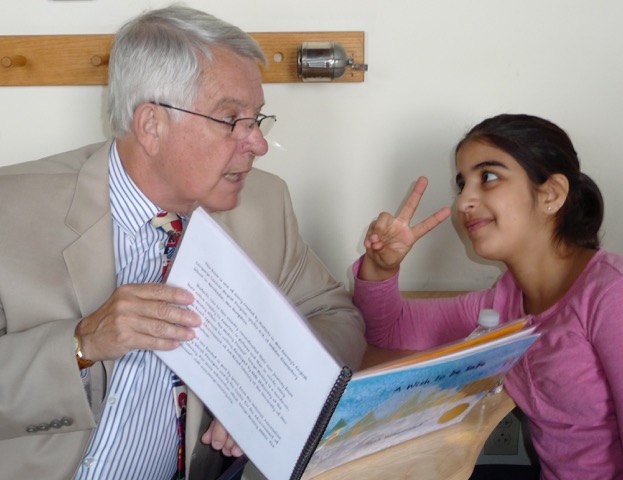
Dennis and Ayat in discussion.
Constructing Story Shape by Shape
During this 2-month project, students undertook in earnest the
process of reconstructing their own or their ancestral family
immigration story. Unique to image-making within the writing process,
students began by creating their own portfolios of hand-painted textured
papers. Using a variety of simple art techniques, students experimented
with color and texture in a systematic yet open-ended way. For our
newcomers, some of whom had never had access to paints before, the
process was particularly compelling.
Following explicit modeling of the process of crafting an
immigration story page by page, students began cutting into their
hand-painted papers and laying shapes onto a background paper. With the
aid of thoughtfully designed storyboards, students created a sequence of
collage images that captured key moments along the journey. Because of
the universality of pictures, this pictures-first approach allows
students to secure their ideas on paper before having to tackle creating
the written text. This makes story drafting particularly accessible to
English learners.
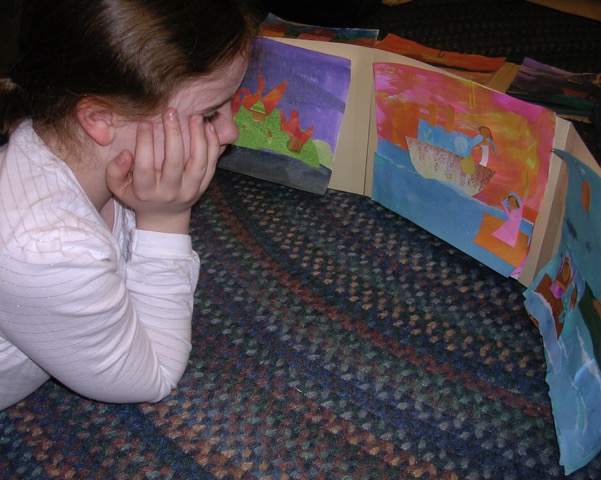
Anna reviewing her work.
Reading the Pictures
Once students’ ideas are glued to the page, they are invited to
read their collage images to access details and description. As
students point to each collage and read that picture, the oral rehearsal
process helps students to “practice their story.” It also helps English
learners identify and learn the words they will need to tell, and
ultimately write, their stories.
The Power of Perspective
Both sets of stories, those created by English learners as well
as those created by native English speakers, are written in the first
person. Though this is an obvious choice for those who actually
experienced the journey, writing from the first-person forces students
who are writing ancestral stories to imagine and relive the journey of
their ancestor as if it were their own. This helps to deepen their
understanding of the immigrant experience.
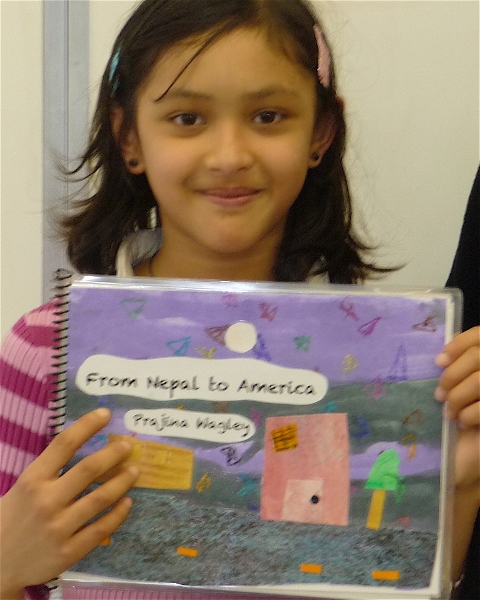
Prajina showing her work.
Finding Common Ground
The experience of creating their own carefully crafted family
story was personally meaningful for all students, and opportunities to
share these family immigration stories resulted in positive impacts far
beyond what was originally imagined. Newcomers and U.S.-born students
discovered that their family stories had many similarities. Alec
observed, “I noticed that today’s immigrants and immigrants from the
past faced the same challenges.” He noted that many came for “pretty
much the same reasons…for religious freedom, need more food, bad choices
were being made in the country…” (Olshansky, 2015).
As our native English speakers tried to imagine the experiences
of their first ancestors to come to America, they developed deep
empathy and respect for those students who had recently arrived in this
country. Zoey shared, “I think that the people who came across were
really brave and stuff. I couldn’t really imagine doing that myself”
(Jones, 2011).
When the students’ books were placed on display, other
students, teachers, administrators, parents, and members of the greater
community developed greater awareness and respect for what our newcomers
have gone through. While the parents of English learners were visibly
proud of the accomplishments of their sons and daughters, other parents
and adults within the community were humbled by what they learned about
the challenges today’s immigrant families face. They were also reminded
that their ancestors experienced similar struggles and once benefited
from the opportunities afforded them at the time of their
arrival.
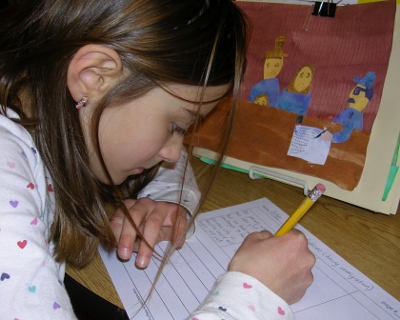
Zoey working hard at writing.
Lessons Learned
At this time in history when immigration has been an explosive
political issue and some politicians seem to have forgotten that they
are here today because their ancestors were once welcomed into this
country, this classroom immigration project served not only to develop
greater awareness but also to build compassion and empathy within the
community. Eight-year-old Alec, wise beyond his years, reminds us, “I
learned that if our ancestors didn’t come over here at the exact period
of time that they did, pretty much all of our lives would have been
different.” Leah realizes that if her grandfather hadn’t arrived exactly
when he did, “he wouldn’t have married who he did so I wouldn’t have
been born” (Olshansky, 2015). For English learners and U.S.-born
students alike, this deep dive into the study of immigration, in the
most personal way, provided students with a deeper understanding of the
role their families play in shaping history.
References
Frankel, S. (2011). Picturing writing: Fostering
literacy through art. Retrieved from
http://www.picturingwriting.org/pdf/AEMDDFindings.pdf
Jones, C. J. (Producer). (2011). Immigration stories
through pictures & words [video segment]. United
States: New Hampshire Chronicle. Retrieved from
http://www.picturingwriting.org/NH_Chronicle.html
Olshansky, B. (2008). The power of pictures: Creating pathways
to literacy through art (pp.188- 190). San Francisco, CA:
Jossey-Bass.
Olshansky, B. (Producer). (2010). Our stories in
pictures and words as told by immigrant and refugee children [DVD]. United States: Center for the
Advancement of Art-Based Literacy, University of New
Hampshire.
Olshansky, B. (2015). Coming to America: Telling our
stories in pictures and words. United States: Center for the
Advancement of Art-Based Literacy, University of New
Hampshire.
Beth Olshansky is director of the Center for the
Advancement of Art-Based Literacy at the University of New Hampshire in
Durham, New Hampshire, USA. You can find links to several video clips
and additional information at her website, Picturing Writing:
Fostering Literacy Through
Art. | 
